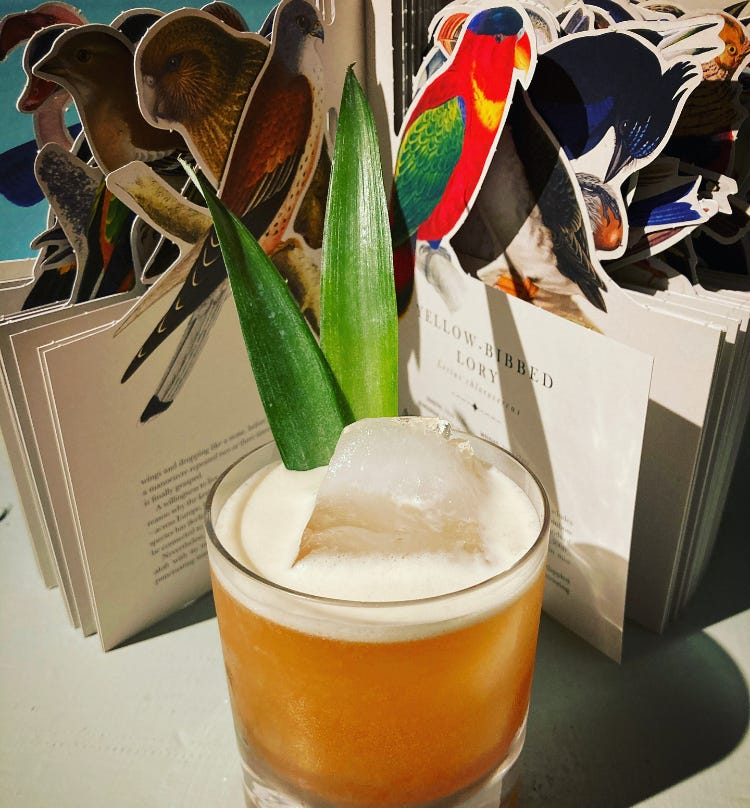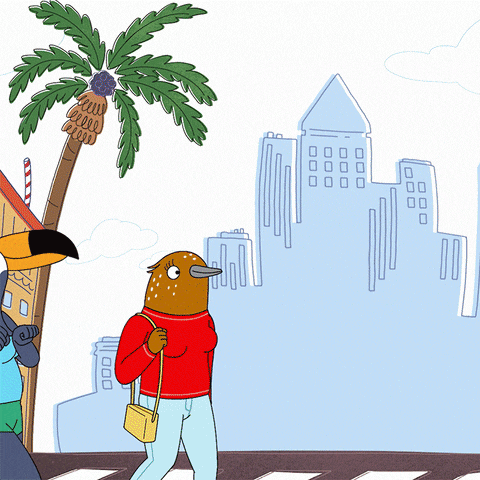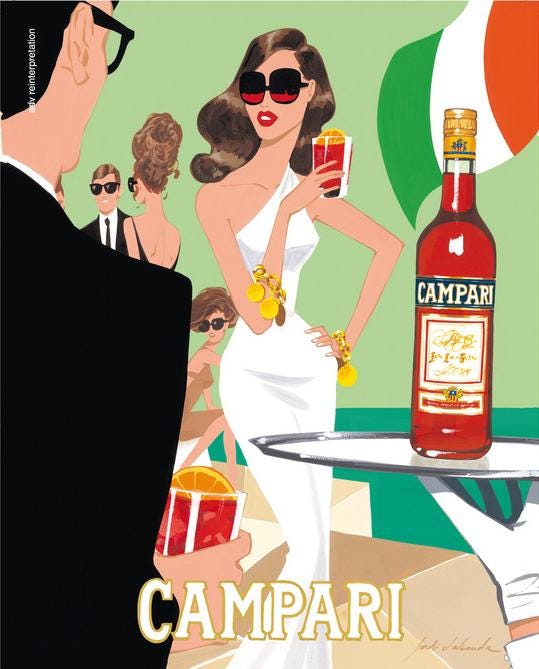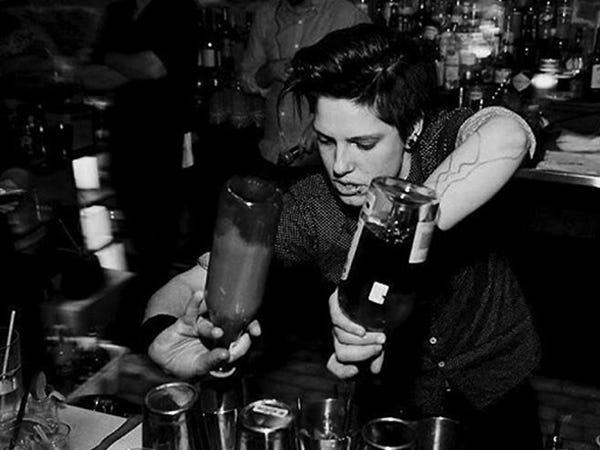The Spirits #8: The Jungle Bird
~ Mr. Ong ~ Ornithology ~ An Almost Comprehensive Guide to Substitions ~ Towards an Emoji Cocktail Cabinet ~
~ THE JUNGLE BIRD ~
45ml dark rum
20ml Campari
15ml lime juice
15ml sugar syrup*
45ml pineapple juice
Place all of your ingredients in a shaker with lots of ice, shake up enthusiastically, then fine strain into pour a large tumbler filled with more ice.** Garnish with a pineapple wedge or if you’re in an elegant mood (as I was above) a couple of fronds. Or get creative with cherries, mint, lemon sails, umbrellas, etc. I don’t care, you’re drinking the damn thing.
*I normally use 2:1 sugar syrup made with golden caster sugar. But this is a cocktail for which a darker sugar syrup made with e.g. demerara or muscovado works pretty well too.
**You can also use crushed ice? In which case, shake it all up and pour unstrained into the glass. Crushed ice is great but a pain. Either purchase one of those £2,000 freezers that makes it for you; alternatively, wrap a fist’s worth of regular cubed ice in a tea-towel/napkin and cudgel it into smithereens on a hard surface. You can also use a blender but be warned, I once broke a blender this way.
(The book, by the way is The Aviary by Matt Merritt).
Anyway. Let’s have some tunes. Oh yeahhhhhhhh.
🦜 🦚 🦜 🦚 🦜 🦚 🦜 🦚 🦜 🦚 🦜 🦚 🦜 🦚 🦜 🦚 🦜 🦚 🦜 🦚
LIKE sassy gifs or office dogs or facemasks or that sexual practise, the Jungle Bird has gone from niche to ubiquitous in little more than a decade. I say ubiquitous. I mean, it’s not like it’s being served at vicarage socials just yet. It’s simply on a lot of hip cocktail menus. And mark my words, once that vaccine kicks in… In fact, if I were to place a bet on the COCKTAIL OF THE 2020s at this early juncture (the Negroni being the cocktail of the 2010s), the Jungle Bird would appear to offer good odds. Not that William Hill knew what I was talking about when I asked them. But give it time!
It dates back to 1973, when it was created by Ong Swee Teik, aka Jeffrey Ong, as the “welcome” drink of the Hilton in Kuala Lumpur, Malaysia, where Mr Ong worked as beverage manager. Immediately, you can identify two points in the Bird’s favour: it comes from the 1970s, an era usually seen as a low point for the cocktail; and it was created outside the traditional western centres of cocktailing. There is an exhaustive three-part article on the origins of the cocktail here in which the author goes to commendable efforts to identify and finally track down Mr Ong (who sadly passed away in 2019). A native of Penang, he was apparently a kind, softly spoken man who created many cocktails - despite the fact that he didn’t touch alcohol himself. As per the article: “His wife once asked him, how did he make all those cocktails when he doesn’t drink? He said he used his nose to smell the aromas, and simply tasted the drinks but not fully consume them.” A lesson to us all!
I also learned that the Jungle Bird was originally served in a bird-shaped vessels in the Hilton’s Aviary bar - called because you could sip while overlooking an aviary, with actual birds flying around you. The birds have since been set free. The bird-shaped vessels have since been stolen. But the Jungle Bird has flown far and wide and is now a sort of unofficial drink of Kuala Lumpur.
It gained wider fame after Jeff ‘Beachbum’ Berry - exhaustive (and exacting) unearther of lost tiki and tropical drinks - included it in one of his books a few years’ back (I came across it via his Total Tiki app). Bartender Giuseppe Gonzalez put it on the menu at Painkiller in New York in 2010… and soon it spread from bar to bar. Now, it’s a standard, with riffs and variants; and there are at least five cocktail bars that I’ve found called Jungle Bird… including this rather fun looking place in KL itself.
It’s not too hard to see why it’s so admired. It contains Campari but unorthodoxly places it in a fruity-zesty context making the Jungle Bird an interesting midpoint between a tropical drink and a craft cocktail. It’s also fun! And delicious! But sophisticated (all those treacly rum notes), with a moreish bitterness. And it looks a treat. It helps that pineapple froths up when you shake it.
Moreover, unlike most tiki-style drinks (which demand three types of rum, nine types of syrup, a mountain of crushed ice, velvet falernum, etc) it’s pretty minimal ingredients-wise. Most bartenders lean towards the heavier “blackstrap” styles of rum; dark, Jamaican rums like the older Appletons will work well too. But don’t sweat it too much. The Jungle Bird is a supremely enjoyable think that you shouldn’t overdrink. Or maybe the other way round. I don’t know, I just thanked two of them.
PLAYLIST
In honour of the Jungle Bird… BIRDS! (Did you know birds are dinosaurs?) Cranes, doves, pigeons, nightingales, Charlie Parker, Oliver Messiaen, the whole freakin’ aviary.
CW: The Tom Lehrer song is out of season but I’m sure you’ll forgive me.
ASK RICHARD
My WhatsApp contacts, passim, ask:
“Alright how’s it going, is it ever OK to use dry vermouth in a Negroni?”
My answer to this is that you must NEVER use dry vermouth in a Negroni. People will laugh at you. Italian grandmothers will haunt you. Someone tried it once in a wet market in Wuhan provence late last year and it did not end well.
Only kidding. I mean, seriously: WHAT’S THE WORST THING THAT’S GOING TO HAPPEN? A slightly dryer than optimal Negroni. Your kitchen will not explode; your first-born will not turn bald; and if you’re out of gin and use salted caramel vodka or whatever, it’s not going to occasion a reactor core meltdown.
My point is: if you find yourself lacking some ingredient or other - substitute it! You can usually find one (or more) thing that will perform the same job. Not only does substituting ingredients mean you can enjoy cocktails you might otherwise not get to enjoy; it means you’re innovating. Make a Jungle Bird with a bourbon if you like, I’m sure Mr. Ong won’t mind. But there are a few points to bear in mind.
A SHORT GUIDE TO SUBSTITUTIONS
So it’s hard to supply a single overarching rule for substituting one ingredient for another - other than you should think less of flavour and more in terms of architecture. What’s that ingredient doing in there? Is it providing sourness? Sweetness? Strength? Fruitiness? Creaminess? Sometimes it’s an effect: like how eggs provide frothiness in a Boston Sour; or a dash of Islay single malt provides smokiness in a Penicillin. Sometimes it’s a particular colour, like the violette in an Aviation. The art is to work out it’s doing - ask if you can do without it (an Aviation minus the violette is still fine) - and if not, think about how you can replace it.
Of these elements, sour is easy. Lemons will substitue for limes and vice versa since what they’re providing is citrussy acidity. (If you’re fresh out of both - cider vinegar?)
Strength isn’t too hard either. I basically mean booziness. Simplest thing is to replace spirits with spirits - light with light, dark with dark, but not necessarily. A Negroni with bourbon in place of gin is a Boulevardier and it’s wonderful.
(But there’s an interesting addendum. You could also replace sourness for its opposite - alkalinity. Try the basic sour formula (50ml spirit, 15ml citrus, 10ml sugar syrup) with milk or cream instead of citrus and you have an Alexander. And you can also replace the strength for its opposite - non-strength. Try making a sour with a non-alcoholic spirit like Seedlip or, say, cold iced tea. Still sort of ‘works’.)
Sweetness gives you more options. I often find I’ve run out of sugar syrup and can’t be bothered to make any more. Anything with concentrated sugar will do: honey, maple syrup, any other syrup (grenadine, orgeat etc) or fruit cordial (elderflower and ginger both great to have around for this reason). And the sweeter liqueurs will work fine as well. Orange liqueur and maraschino have ample sugar to play a sugar-like function and indeed were usually used primarily to add sweetness to early cocktails. The cocktail might then need a little extra dilution or less of the base spirit to make up for it.
It becomes more complicated when an ingredient is doing more than one job. Take, for example, the Margarita: tequila, orange liqueur, lime. The tequila is the strength. The lime is sourness. The orange liqueur is providing some alcohol, some orange-y flavour but mostly but mostly it’s providing sugar. Orange juice would be a bad subsitution: it’s not sweet enough on its own to counteract the acid of the lime or the strength of the tequila. Sugar syrup would be OK… but a little meh. Agave syrup is better (that gives you a Tommy’s Margarita). And agave syrup plus a splash of orange juice or a spray of orange peel is perhaps best of all. Cointreau (the most commonly found orange liqueur) is £25. Here is a cheaper, less boozy and whisper it, kind of better alternative.
When it comes to juices (pineapple, grapefruit, orange, etc), again, don’t be too distracted by flavour - just try something else that has similar sweetness/acidity/bitterness. So, mango for pineapple, say. Apple for orange (but you might want a tiny spritz of lemon juice in there for tartness.) Cranberry for grapefruit? And so on.
Below is a more specific guide to subs and variants you might like to try for the main types of booze.
🍸 Gin: any other white spirit. Zubrowka is good. Some of the more floral/aromatic aged spirits are good too, e.g. Irish whiskey, reposado tequila, aquavit. Fino sherry (which is bone dry) often works in place of gin, as does dry vermouth (you might need to temper the sweetness elsewhere. If using vodka (which tastes of zilch) you might consider flash infusing it with herbal tea for ten minutes.
🥃 Bourbon: any other dark spirit. Rum almost always works in bourbon contexts! As does brandy. Or you might infuse a lighter spirit with black tea for ten minutes.
🌴 Rum: well, again, try light spirits for light rum (pisco and grappa are excellent), dark for dark. You might sub in some demerara sugar syrup for your regular sugar syrup for a deeper rummier flavour.
🌵 Tequila/Mezcal: same principle - but I would especially commend fino sherry here for its vegetal dryness.
🐻 Vodka: literally any other spirit.
🍇 Brandy: again, dark spirits, especially medium golden rums are nice. And you might try pisco too.
🏴 Scotch: other whiskeys. And tequila is usually good (or mezcal for the smokier Islays)
🇫🇷 French Vermouth: I mean the dry stuff. Sherry is good: dry (fino or manzanilla). White port. Lillet Blanc (sweeter than dry vermouth, but delicious). Or try white wine? I made a “Negroni” with some Argentinian Torrontes, Campari and white rum the other day. Pretty good.
🇮🇹 Italian Vermouth: The sweeter stuff. Medium sherries, ruby/tawny port, Madeira, Marsala, sweet white vermouth (like Cocchi di Torino), etc - or red wine and a dash of sugar,. You might even try an amaro like Cynar.
🍊 Orange Liqueur: almost always used as a sweetner in cocktails. So, try honey, sugar, maple syrup, agave syrup, maybe with a splash of orange juice? Or a spritz of orange zest. Marmalade does the job too.
🍒 Maraschino: also usually used as a sweetener, so same as above, but anything you can use to impart a cherry-almondy flavour is good. Or just try orange liqueur.
🩸 Campari: cranberry juice isn’t a bad idea - it’s red, it’s bittersweet, it performs a similar job. Else any other amaro (Cynar, Aperol, Averna, etc). Or perhaps marmalade plus a dash of extra bitters.
⛪ Bénédictine: this will usually substitute for similarly dark, sweet, desserty liqueurs, like creme de cacao, coffee liqueur, Cuaranta y Tres, etc. Or maybe try something like melted dark chocolate mixed with maple syrup? A thought.
🌿 Chartreuse: other herbal/piney liqueurs. Or: flash infuse some herbs/green tea in gin or vodka for ten minutes, add a little sugar and oomph.
🐲 Absinthe: pastis is going to work fine. Absinthe is almost always used as seasoning in cocktails - so anything with a touch of anise is good. A few fennel seeds in a shaker?
💜 Creme de cassis: Ribena.
🌳 Elderflower liqueur: Elderflower cordial (and so on…)
🍑🍐 🍓 Other fruit liqueurs: berries for berries, orchard fruits for orchard fruits, if you can. Jam will often do just as good a job - as will squash/cordial.
WHAT I’M READING
The struggle for America’s soul, by John Gray (New Statesman).
The Substackerati - or, why every other journalist is starting a Substack newsletter. (Columbia Journalism Review).
And here’s a good example of a fun Substrack. Steve Lord writes about weird little online subcultures. Here, he looks at Gopher and Gemini, two alternate, commerce-free, and still extant internets dating back to the 1990s (Lord still accesses Gopher via his Amiga!). (Tales from the Dork Web).
I wrote this piece about MONEY! (Observer).
And this about JD Vance’s book Hillbilly Elegy (UnHerd).
SHOPPING LIST
Still enjoying that rum? Good: dark rum, sugar, Angostura bitters, apple juice, apples. Some apple-pie type spices might not go amiss. As per above - you can make this one with other dark spirits too. 🍏









Hi Bartender
Once I got the pineapple juice sorted, the Jungle Bird is quite a delicious cocktail. In fact, I had two! I love the frothy head and the sweet/sour flavours; excellent. This is one I will be definitely trying on privileged guests, once we can receive them in safe circumstances, of course.
And the origin of Jungle Bird is truly interesting; how a favoured drink can resonate through the years and across the globe. I haven’t been to Hilton in KL but stayed the other side of the twin towers at the Concorde Hotel in February 2009. If you’re in a hotel on business, its rare you get offered a welcoming drink. In fact, about the only place that has happened to me regularly was in Mauritius. The photo you set; isn’t that the Menara Bank? Its just behind the Concorde. Actually, if you come out of the hotel and turn to the left there is (or was) a string of bars. In one, there was a superb band from Kenya playing a residency. I was so impressed I took some details and passed them on to the BBC. I got a stock answer back so I don’t think they were followed up. And I cannot even remember their name….although I must have it in one of my diaries I suppose.
Oh, and a good addition to your playlist would be ‘Freebird’ by Lynyrd Skynyrd, of course.
Cheers
For all Apple Music users out there - here is week 8's playlist:
https://music.apple.com/gb/playlist/the-spirits-week-7/pl.u-38oWroEsZgPp4G